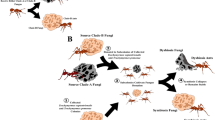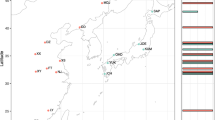Abstract
Host-associated microbes facilitate diverse biotic and abiotic interactions between hosts and their environments. Experimental alterations of host-associated microbial communities frequently decrease host fitness, yet much less is known about if and how host-microbiome interactions are altered by natural perturbations, such as introduction events. Here, we begin to assess this question in Onthophagus dung beetles, a species-rich and geographically widely distributed genus whose members rely on vertically transmitted microbiota to support normal development. Specifically, we investigated to what extent microbiome community membership shifts during host introduction events and the relative significance of ancestral associations and novel environmental conditions in the structuring of microbial communities of introduced host species. Our results demonstrate that both evolutionary history and local environmental forces structure the microbial communities of these animals, but that their relative importance is shaped by the specific circumstances that characterize individual introduction events. Furthermore, we identify microbial taxa such as Dysgonomonas that may constitute members of the core Onthophagus microbiome regardless of host population or species, but also Wolbachia which associates with Onthophagus beetles in a species or even population-specific manner. We discuss the implications of our results for our understanding of the evolutionary ecology of symbiosis in dung beetles and beyond.




Similar content being viewed by others
Data Availability
All 16S rRNA sequences are accessible on the NIH Sequence Read Archive (SRA) under the accession number PRJNA599403.
References
Foray V, Perez-Jimenez MM, Fattouh N, Landmann F (2018) Wolbachia control stem cell behavior and stimulate germline proliferation in filarial nematodes. Dev Cell 45(2):198–211
Hooper LV, Gordon JI (2001) Commensal host-bacterial relationships in the gut. Science 292(5519):1115–1118
Sommer F, Bäckhed F (2013) The gut microbiota—masters of host development and physiology. Nat Rev Microbiol 11(4):227–238
McFall-Ngai MJ (2014) The importance of microbes in animal development: lessons from the squid-vibrio symbiosis. Annu Rev Microbiol 68:177–194
Shikuma NJ, Pilhofer M, Weiss GL, Hadfield MG, Jensen GJ, Newman DK (2014) Marine tubeworm metamorphosis induced by arrays of bacterial phage tail–like structures. Science 343(6170):529–533
Sneed JM, Sharp KH, Ritchie KB, Paul VJ (2014) The chemical cue tetrabromopyrrole from a biofilm bacterium induces settlement of multiple Caribbean corals. Proceedings of the Royal Society B: Biological Sciences 281(1786):20133086
Whalan S, Webster NS (2014) Sponge larval settlement cues: the role of microbial biofilms in a warming ocean. Sci Rep 4:4072
Leonardo TE, Mondor EB (2006) Symbiont modifies host life-history traits that affect gene flow. Proc R Soc Lond B Biol Sci 273(1590):1079–1084
Emelianoff, V., Chapuis, E., le Brun, N., Chiral, M., Moulia, C., and Ferdy, J. B. (2008) A survival- reproduction trade-off in entomopathogenic nematodes mediated by their bacterial symbionts. Evolution, 932-942
Chu C, Murdock MH, Jing D, Won TH, Chung H, Kressel AM et al (2019) The microbiota regulate neuronal function and fear extinction learning. Nature 574(7779):543–548
Vuong, H. E., Yano, J. M., Fung, T. C., & Hsiao, E. Y. (2017). The microbiome and host behavior. Annu Rev Neurosci, 40(1), 21–49. https://doi.org/10.1146/annurev-neuro-072116-031347
Douglas AE (2009) The microbial dimension in insect nutritional ecology. Funct Ecol 23(1):38–47. https://doi.org/10.1111/j.1365-2435.2008.01442.x
Gilbert, S. F. (2019). Developmental symbiosis facilitates the multiple origins of herbivory. Evolution & development, e12291
McFall-Ngai M, Hadfield MG, Bosch TCG, Carey HV, Domazet-Lošo T, Douglas AE et al (2013) Animals in a bacterial world, a new imperative for the life sciences. Proc Natl Acad Sci 110(9):3229–3236. https://doi.org/10.1073/pnas.1218525110
Morimoto J, Simpson SJ, Ponton F (2017) Direct and trans-generational effects of male and female gut microbiota in Drosophila melanogaster. Biol Lett 13:20160966. https://doi.org/10.1098/rsbl.2016.0966
Rosenberg, E., & Zilber-Rosenberg, I. (2013). The hologenome concept: human, animal and plant microbiota. In The Hologenome Concept: Human, Animal and Plant Microbiota https://doi.org/10.1007/978-3-319-04241-1
Parker ES, Dury GJ, Moczek AP (2018) Transgenerational developmental effects of species-specific, maternally transmitted microbiota in Onthophagus dung beetles. Ecological Entomology. https://doi.org/10.1111/een.12703
Schwab DB, Riggs HE, Newton ILG, Moczek AP (2016) Developmental and ecological benefits of the maternally transmitted microbiota in a dung beetle. Am Nat 188(6):000–000. https://doi.org/10.1086/688926
Tarasov SI, Kabakov ON (2010) Two new species of Onthophagus (Coleoptera: Scarabaeidae) from Indochina, with a discussion of some problems with the classification of Serrophorus and similar subgenera. Zootaxa 2344:17–28
Frank K, Brückner A, Hilpert A, Heethoff M, Blüthgen N (2017) Nutrient quality of vertebrate dung as a diet for dung beetles. Sci Rep 7(1):1–12. https://doi.org/10.1038/s41598-017-12265-y
Holter P (2016) Herbivore dung as food for dung beetles: elementary coprology for entomologists. Ecological Entomology 41(4):367–377. https://doi.org/10.1111/een.12316
Goidanich, A., & Malan, C. E. (1962). Sulla fonte di alimentazione e sulla microflora aerobica del nido pedotrofico e dell'apparato digerente delle larve di scarabei coprogagi: (Coleoptera scarabaeidae)
Rougon D, Rougon C, Levieux J, Trichet J (1990) Variations in the amino-acid content in zebu dung in the Sahel during nesting by dung-beetles (Coleoptera, Scarabaeidae). Soil Biol Biochem 22(2):217–223. https://doi.org/10.1016/0038-0717(90)90090-M
Estes, A. M., Hearn, D. J., Snell-Rood, E. C., Feindler, M., Feeser, K., Abebe, T., Dunning Hotopp J.C. Moczek, A. P. (2013). Brood ball-mediated transmission of microbiome members in the dung beetle, Onthophagus taurus (Coleoptera: Scarabaeidae). PLoS One, 8(11), 1–15. https://doi.org/10.1371/journal.pone.0079061
Shukla SP, Sanders JG, Byrne MJ, Pierce NE (2016) Gut microbiota of dung beetles correspond to dietary specializations of adults and larvae. Mol Ecol 25(24):6092–6106. https://doi.org/10.1111/mec.13901
Edwards, P. (2007) Introduced dung beetles in Australia 1967-2007, 1–66
Silva DP, Vilela B, Buzatto BA, Moczek AP, Hortal J (2016) Contextualized niche shifts upon independent invasions by the dung beetle Onthophagus taurus. Biol Invasions 18(11):3137–3148. https://doi.org/10.1007/s10530-016-1204-4
Vulinec K, Eudy SP (1993) A southern range extension for the introduced dung beetle Onthophagus taurus Schreber (Coleoptera: Scarabaeidae). Coleopt Bull 47(2):129–130
Floate KD, Watson DW, Weiss RM, Olfert O (2017) Bioclimatic analyses for the distributions of Onthophagus nuchicornis, Onthophagus taurus, and Digitonthophagus gazella (Coleoptera: Scarabaeidae) in North America. Can Entomol 149(4):504–524. https://doi.org/10.4039/tce.2017.20
De Vrieze J, Regueiro L, Props R, Vilchez-Vargas R, Jáuregui R, Pieper DH et al (2016) Presence does not imply activity: DNA and RNA patterns differ in response to salt perturbation in anaerobic digestion. Biotechnology for Biofuels 9:1–13. https://doi.org/10.1186/s13068-016-0652-5
Caporaso JG, Lauber CL, Walters WA, Berg-Lyons D, Huntley J, Fierer N, Owens SM, Betley J, Fraser L, Bauer M, Gormley N, Gilbert JA, Smith G, Knight R (2012) Ultra-high-throughput microbial community analysis on the Illumina HiSeq and MiSeq platforms. ISME J 6:1621–1624. https://doi.org/10.1038/ismej.2012.8
Schloss PD, Westcott SL, Ryabin T, Hall JR, Hartmann M, Hollister EB et al (2009) Introducing mothur: open-source, platform-independent, community-supported software for describing and comparing microbial communities. Appl Environ Microbiol 75(23):7537–7541
Quast C, Pruesse E, Yilmaz P, Gerken J, Schweer T, Yarza P et al (2012) The SILVA ribosomal RNA gene database project: improved data processing and web-based tools. Nucleic Acids Res 41(D1):D590–D596
Price MN, Dehal PS, Arkin AP (2010) FastTree 2 -- approximately maximum-likelihood trees for large alignments. PLoS One 5(3):e9490. https://doi.org/10.1371/journal.pone.0009490
R Core Team (2013). R: A language and environment for statistical computing
McMurdie PJ, Holmes S (2013) Phyloseq: an R package for reproducible interactive analysis and graphics of microbiome census data. PLoS One 8(4):e61217
Oksanen, J., Blanchet, F. G., Friendly, M., Kindt, R., Legendre, P., McGlinn, D., ... & Stevens, M. H. H. (2018). vegan: Community Ecology Package. R package version 2.5–2. 2018
Wickham, H. (2016). ggplot2: elegant graphics for data analysis. Springer
White JR, Nagarajan N, Pop M (2009) Statistical methods for detecting differentially abundant features in clinical metagenomic samples. PLoS Comput Biol 5(4):e1000352
Mazel F, Davis KM, Loudon A, Kwong WK, Groussin M, Parfrey LW (2018) Is host filtering the main driver of phylosymbiosis across the tree of life? MSystems 3(5):e00097–e00018. https://doi.org/10.1128/msystems.00097-18
Brooks AW, Kohl KD, Brucker RM, van Opstal EJ, Bordenstein SR (2016) Phylosymbiosis: relationships and functional effects of microbial communities across host evolutionary history. PLoS Biol 14(11):e2000225. https://doi.org/10.1371/journal.pbio.2000225
Brucker RM, Bordenstein SR (2013) The hologenomic basis of speciation. Science 466(August):667–669. https://doi.org/10.1126/science.1240659
Kohl KD, Dearing MD, Bordenstein SR (2018) Microbial communities exhibit host species distinguishability and phylosymbiosis along the length of the gastrointestinal tract. Mol Ecol 27(8):1874–1883. https://doi.org/10.1111/mec.14460
Groussin M, Mazel F, Sanders JG, Smillie CS, Lavergne S, Thuiller W, Alm EJ (2017) Unraveling the processes shaping mammalian gut microbiomes over evolutionary time. Nat Commun 8. https://doi.org/10.1038/ncomms14319
Hajek AE, Nielsen C, Kepler RM, Long SJ, Castrillo L (2013) Fidelity among Sirex woodwasps and their fungal symbionts. Microb Ecol 65(3):753–762. https://doi.org/10.1007/s00248-013-0218-z
Wooding AL, Wingfield MJ, Hurley BP, Garnas JR, De Groot P, Slippers B (2013) Lack of fidelity revealed in an insect-fungal mutualism after invasion. Biol Lett 9(4):20130342. https://doi.org/10.1098/rsbl.2013.0342
Cheng, D., Chen, S., Huang, Y., Pierce, N. E., Id, M. R., Yang, F., … Id, Y. X. (2019). Symbiotic microbiota may reflect host adaptation by resident to invasive ant species. PLoS Pathog, 1–22. Retrieved from https://doi.org/10.1371/journal.ppat.1007942
Mueller, U. G., Mikheyev, A. S., Hong, E., Sen, R., Warren, D. L., Solomon, S. E., Ishak H.D., Cooper M., Miller J.L., Shaffer K.A. Juenger, T. E. (2011). Evolution of cold-tolerant fungal symbionts permits winter fungiculture by leafcutter ants at the northern frontier of a tropical ant-fungus symbiosis. Proceedings of the National Academy of Sciences, 108(10), 4053–4056. https://doi.org/10.1073/pnas.1015806108
Gundale MJ, Almeida JP, Wallander H, Wardle DA, Kardol P, Nilsson MC et al (2016) Differences in endophyte communities of introduced trees depend on the phylogenetic relatedness of the receiving forest. J Ecol 104(5):1219–1232. https://doi.org/10.1111/1365-2745.12595
Monteith, G., & Kenyon, T. (2011). Report on a survey of dung beetles (Coleoptera: Scarabaeinae) from the Moggill Creek Catchment Brisbane. Brisbane
Liu N, Zhang L, Zhou H, Zhang M, Yan X, Wang Q, Long Y, Xie L, Wang S, Huang Y, Zhou Z (2013) Metagenomic insights into metabolic capacities of the gut microbiota in a fungus-cultivating termite (Odontotermes yunnanensis). PLoS One 8(7):e69184
Shinzato N, Muramatsu M, Watanabe Y, Matsui T (2005) Termite-regulated fungal monoculture in fungus combs of a macrotermitine termite Odontotermes formosanus. Zool Sci 22(8):917–923
Hilgenboecker K, Hammerstein P, Schlattmann P, Telschow A, Werren JH (2008) How many species are infected with Wolbachia?–a statistical analysis of current data. FEMS microbiology letters 281(2):215–220
Werren, J. H., & Windsor, D. M. (2000). Wolbachia infection frequencies in insects: evidence of a global equilibrium?. Proceedings of the Royal Society of London. Series B: Biological Sciences, 267(1450), 1277–1285
Newton, I. L., & Rice, D. W. (2019). The Jekyll and Hyde symbiont: could Wolbachia be a nutritional mutualist?. J Bacteriol
Hedges LM, Brownlie JC, O'Neill SL, Johnson KN (2008) Wolbachia and virus protection in insects. Science 322(5902):702–702
Werren JH, Baldo L, Clark ME (2008) Wolbachia: master manipulators of invertebrate biology. Nat Rev Microbiol 6(10):741–751. https://doi.org/10.1038/nrmicro1969
Sintupachee S, Milne JR, Poonchaisri S, Baimai V, Kittayapong P (2006) Closely related Wolbachia strains within the pumpkin arthropod community and the potential for horizontal transmission via the plant. Microb Ecol 51(3):294–301. https://doi.org/10.1007/s00248-006-9036-x
Hughes GL, Dodson BL, Johnson RM, Murdock CC, Tsujimoto H, Suzuki Y et al (2014) Native microbiome impedes vertical transmission of Wolbachia in Anopheles mosquitoes. Proc Natl Acad Sci 111(34):12498–12503
Sudakaran S, Kost C, Kaltenpoth M (2017) Symbiont acquisition and replacement as a source of ecological innovation. Trends Microbiol. https://doi.org/10.1016/j.tim.2017.02.014
Acknowledgments
We are deeply grateful to I. Piccini, B. Nervo, P. Gleeson, and T. Kijimoto for field collection and shipment of beetles and to A. Lindsey for generously sharing her time, expertise, and resources.
Funding
Support for this study was provided by National Science Foundation grants IOS 1256689 and 1901680 to APM as well as grant 61369 from the John Templeton Foundation. The opinions, interpretations, conclusions, and recommendations are those of the authors and are not necessarily endorsed by the National Science Foundation, or the John Templeton Foundation.
Author information
Authors and Affiliations
Contributions
ESP, APM, and ILGN designed the experiments; ESP performed the experiments; ESP analyzed the data; ESP and APM wrote the paper with revisions from ILGN. All authors have approved the manuscript.
Corresponding author
Ethics declarations
Conflict of Interest
The authors declare that they have no conflict of interest.
Electronic supplementary material
ESM 1
(PDF 907 kb)
Rights and permissions
About this article
Cite this article
Parker, E.S., Newton, I.L. & Moczek, A.P. (My Microbiome) Would Walk 10,000 miles: Maintenance and Turnover of Microbial Communities in Introduced Dung Beetles. Microb Ecol 80, 435–446 (2020). https://doi.org/10.1007/s00248-020-01514-9
Received:
Accepted:
Published:
Issue Date:
DOI: https://doi.org/10.1007/s00248-020-01514-9




